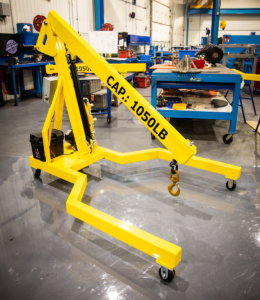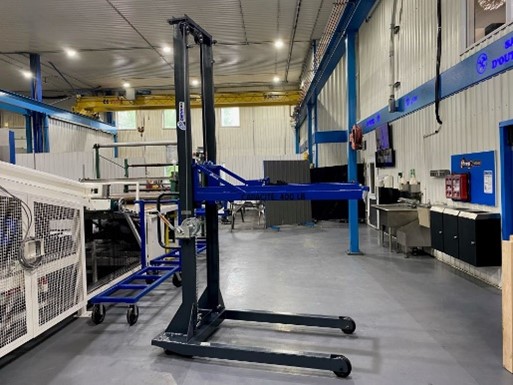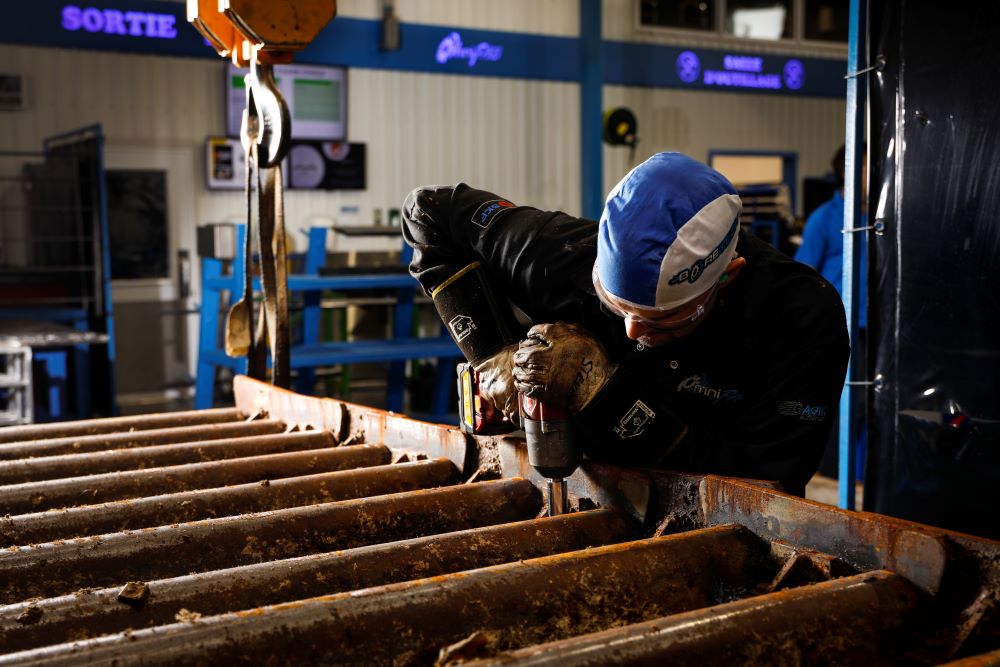The main types of lifting equipment used in the industrial sector
A lifting gear is a mechanical device used to lift, move, or handle heavy or bulky loads. This equipment is designed to facilitate the vertical or horizontal movement of loads that would otherwise be difficult or impossible to handle manually, due to their weight, size, or nature.
At Omnifab, we specialize in the design, manufacture, repair, maintenance and certification of lifting equipment.
For companies in the industrial sector, it’s important to know that this equipment can take many forms, so that they are sometimes categorized in different ways.
All these types of industrial lifting equipment have unique characteristics, making them suited to certain working environments, and to the handling of particular products.
In this article, learn more about several types of lifting equipment. But first, let’s review some of the features of Omnifab’s lifting equipment design and manufacturing service.
Design and manufacture of lifting devices at Omnifab
At Omnifab, we focus our efforts on creating “custom” lifting equipment, meaning equipment tailored to our customers’ specific applications. We therefore have no “standard” lifting equipment in stock.
All our projects include an engineering phase, which precedes the manufacturing and installation phases. During this first phase, our engineers analyze the customer’s needs, then design the equipment to meet them. Once the plans have been approved, manufacturing can begin.
In other words, if there’s no lifting equipment on the market to meet your needs, ours can incorporate all the functions and features you need to improve or automate your production activities.
Our custom-built lifts are sturdy, safe and compliant.
Since our own engineers design our hoists, we can be sure that they always meet all the specifications and certifications required (load, reach, etc.), as well as the standards governing our customers’ sectors of activity.
Furthermore, as we manufacture many of the components of our machines and assemble them ourselves, the quality of every aspect of our products is guaranteed.
And when it comes to the installation of our fixed lifting equipment, our external industrial mechanics team travels all over Quebec to take care of it.
We offer the shortest lead times
Customers who entrust us with a custom-built hoist project can rest assured that it will be completed quickly after formalizing their order.
Exceptions to help out our customers
You need a standard lifting device, but no supplier can offer you a fast enough lead time?
In that case, we could supply the equipment you need in a matter of days, saving you production delays.
Now let’s get down to business and review the most common types of lifting equipment.
Do you need a lifting device that's perfectly suited to your needs?
1 – The spreader bar
Spreader beams are long metal bars that hold two slings (flexible lifting accessories made of rope or webbing, wire rope or chain, usually terminated by metal components such as meshes, hooks or rings) apart, distributing the weight of a load evenly over one or more attachment points.
2 – Monorail hoists (sometimes called single-girder overhead travelling cranes)
Monorail lifting systems are often used in manufacturing facilities. They are usually mounted directly on the ceiling of buildings, freeing up floor space.
In a monorail system, loads move directly under the monorail hoist (no lateral movement). This makes monorails ideal for moving loads between different workstations. The route a monorail hoist can take is highly flexible. Curves and bends are possible, as are changes in level.
Loads are usually lifted and then physically moved along the monorail by operators, but motorized and automated monorail lifting systems are also available.
Monorails are often used to install or remove specific equipment and parts, such as motors and gearboxes, in hard-to-reach locations. Monorails can also have their own structure.
3 – The rolling gantry crane
Gantry cranes are easy-to-handle lifting devices for use in a variety of working environments, such as factories, garages, warehouses and more.
Generally speaking, all rolling gantry cranes are made up of the same components. First of all, they include a horizontal structure, the “bridge”, onto which one or more carts can be added to move from one side of the bridge to the other. A hoist can also be added to the cart, depending on lifting requirements.
The gantry crane is wheeled, making it easy to transport to wherever it’s needed. Some models can also be mounted on rails, hence the name “rolling gantry crane” sometimes used.
4 – The jib crane
A jib crane is a type of overhead lifting device frequently used in small work cells for one-off and repetitive lifting tasks.
Jib cranes have several basic features that vary according to the type of crane: the jib, the mast and the hoist. The jib is the horizontal beam that extends from the support and holds the load. The mast is the vertical beam or steel tube that supports the jib and allows the system to pivot. The mobile hoist is used to lift, position, and lower a load.
Another component of most jib cranes is the cart. This can be manual, motorized, or pneumatic. In addition, it carries the hoist, rope (or chain) and hook along the entire length of the jib.
Rotation may vary according to crane type. Wall-mounted and column-mounted jib cranes offer 180 to 200 degrees of rotation, while freestanding and mast-mounted cranes can achieve 360 degrees of boom rotation. An electric or pneumatic motor can be added to the mast to provide rotation assistance.
Jib cranes improve safety, increase worker productivity, and reduce workplace accidents. They are generally easy to use and require little maintenance thanks to their relatively simple design.
5 – Lift table (sometimes called freight elevator)
A lift table is a platform capable of holding materials and raising or lowering them to the ideal height. In this way, the table can be adjusted to suit the needs of a specific application and the requirements of the user.
Lift tables are supported by a solid, rigid and stable chassis, placed flat on the ground, in a pit, or equipped with rollers or wheels. The majority of lift tables are equipped with scissor-type feet that ensure smooth, straight vertical movement for smooth operation and positioning.
There are also different types of lift table:
- Manual lift tables ;
- Pneumatic lifting tables ;
- Hydraulic lift tables;
- Electric lifting tables.
All these types of lift table provide an easily accessible work surface that can be adjusted to meet the needs of various industrial applications, such as parts sorting, repairs, tool storage or the provision of a flexible workspace in a limited or enclosed area.

6 – The workshop crane
Workshop cranes are handling and lifting equipment that can be mobile or stationary. Generally manufactured in compact dimensions, they are designed to lift and move heavy parts with excellent stability and maneuverability.
The base of the workshop crane, either a frame or a mooring base, supports a fixed vertical arm to which the jib is attached by means of a pivot link. The arrow can be raised or lowered by means of a hydraulic cylinder which connects it to the vertical arm. Boom height and length vary according to model.
The workshop crane is also sometimes referred to as a “lifting goat”, or even as a “motor lift” or “motor goat”, the latter two terms referring to the very frequent use of this lifting device.

7 – Overhead Cranes
Similar to monorail lifting systems, overhead cranes are lifting systems installed at height, often mounted to the structure of a building. They allow for the movement of heavy loads across large areas, particularly in factories, warehouses, and production sites.
Their main advantage is freeing up floor space while facilitating the handling of bulky loads. For example, they are commonly used to lift and move metal coils in steel mills.
8 – Winches
Winches are compact lifting devices that use a drum and cable to lift or pull loads. They can be electric, hydraulic, or manual and are used in a variety of industrial and construction applications, including lifting equipment on construction sites or moving loads in tight spaces.
9 – Forklifts
Indispensable in warehouses and storage areas, forklifts are designed to move pallets and loads over short distances. They come in several variants, including manual lift trucks and electric, thermal, and all-terrain forklifts, each adapted to specific working environments.

10 – Hydraulic Jacks
Hydraulic jacks are used to lift or adjust loads with high precision. They are used in industrial presses, machine tools, and various lifting equipment. Their ability to generate significant force in a compact space makes them versatile tools.
11 – Load Tilters
Load tilters are equipment designed to tilt or invert heavy loads to facilitate handling. They are commonly used in manufacturing, logistics, and warehouses to reposition pallets, containers, or material coils.

Omnifab is the standard for custom-built lifting equipment in Quebec.
In conclusion, there is undoubtedly a type of lifting device that could help you optimize your industrial operations.
At Omnifab, we can help you identify which one, and even custom-build one to meet your specific requirements with unique features. We can also modify existing lifting equipment or certify it.
Contact us with your requirements, and our engineers, machinists, welders and industrial mechanics will all put their shoulders to the wheel to provide you with the best lifting equipment for your applications.

